3-3 duoprism
3-3 duoprisms Schlegel diagram | |
|---|---|
| Type | Uniform duoprism |
| Schläfli symbol | {3}×{3} = {3}2 |
| Coxeter diagram | |
| Cells | 6 triangular prisms |
| Faces | 9 squares, 6 triangles |
| Edges | 18 |
| Vertices | 9 |
| Vertex figure | 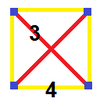 Tetragonal disphenoid |
| Symmetry | [[3,2,3]] = [6,2+,6], order 72 |
| Dual | 3-3 duopyramid |
| Properties | convex, vertex-uniform, facet-transitive |
In geometry of 4 dimensions, a 3-3 duoprism, the smallest p-q duoprism, is a 4-polytope resulting from the Cartesian product of two triangles.
It has 9 vertices, 18 edges, 48 faces (9 squares, and 6 triangles), in 6 triangular prism cells. It has Coxeter diagram ![]()
![]()
![]() , and symmetry [[3,2,3]], order 72.
, and symmetry [[3,2,3]], order 72.
Images
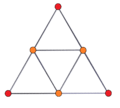 |
 |
 |
 |
| 2D orthogonal projection | |||
|---|---|---|---|
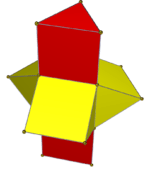 |
 | ||
| Net | Vertex-centered perspective | ||
Symmetry
In 5-dimensions, the some uniform 5-polytopes have 3-3 duoprism vertex figures, some with unequal edge-lengths and therefore lower symmetry:
| Symmetry | [[3,2,3]], order 72 | [3,2], order 12 | ||
|---|---|---|---|---|
| Coxeter diagram |
||||
| Schlegel diagram |
 |
 |
 |
 |
| Name | t2α5 | t03α5 | t03γ5 | t03β5 |
The birectified 16-cell honeycomb also has a 3-3 duoprism vertex figures. There are three constructions for the honeycomb with two lower symmetries.
| Symmetry | [3,2,3], order 36 | [3,2], order 12 | [3], order 6 |
|---|---|---|---|
| Coxeter diagram |
|||
| Skew orthogonal projection |
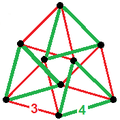 |
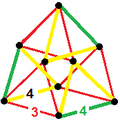 |
 |
Related polytopes
| Space | Finite | Euclidean | Hyperbolic | ||
|---|---|---|---|---|---|
| n | 4 | 5 | 6 | 7 | 8 |
| Coxeter group |
2A2 | A5 | E6 |  =E6+ =E6+ |
 =E6++ =E6++ |
| Coxeter diagram |
|||||
| Symmetry | [[3<sup>2,2,-1</sup>]] | [[3<sup>2,2,0</sup>]] | [[3<sup>2,2,1</sup>]] | [[3<sup>2,2,2</sup>]] | [[3<sup>2,2,3</sup>]] |
| Order | 72 | 1440 | 103,680 | ∞ | |
| Graph |  |
 |
 |
∞ | ∞ |
| Name | −122 | 022 | 122 | 222 | 322 |
3-3 duopyramid
| 3-3 duopyramid | |
|---|---|
| Type | Uniform dual duopyramid |
| Schläfli symbol | {3}+{3} = 2{3} |
| Coxeter diagram | |
| Cells | 9 tetragonal disphenoids |
| Faces | 18 isosceles triangles |
| Edges | 15 (9+6) |
| Vertices | 6 (3+3) |
| Symmetry | [[3,2,3]] = [6,2+,6], order 72 |
| Dual | 3-3 duoprism |
| Properties | convex, vertex-uniform, facet-transitive |
The dual of a 3-3 duoprism is called a 3-3 duopyramid. It has 9 tetragonal disphenoid cells, 18 triangular faces, 15 edges, and 6 vertices.
It can be seen in orthogonal projection as a 6-gon circle of vertices, and edges connecting all pairs, just like a 5-simplex seen in projection.
See also
- 3-4 duoprism
- Tesseract (4-4 duoprism)
- 5-5 duoprism
- Convex regular 4-polytope
- Duocylinder
Notes
References
- Regular Polytopes, H. S. M. Coxeter, Dover Publications, Inc., 1973, New York, p. 124.
- Coxeter, The Beauty of Geometry: Twelve Essays, Dover Publications, 1999, ISBN 0-486-40919-8 (Chapter 5: Regular Skew Polyhedra in three and four dimensions and their topological analogues)
- Coxeter, H. S. M. Regular Skew Polyhedra in Three and Four Dimensions. Proc. London Math. Soc. 43, 33-62, 1937.
- John H. Conway, Heidi Burgiel, Chaim Goodman-Strass, The Symmetries of Things 2008, ISBN 978-1-56881-220-5 (Chapter 26)
- Norman Johnson Uniform Polytopes, Manuscript (1991)
- N.W. Johnson: The Theory of Uniform Polytopes and Honeycombs, Ph.D. Dissertation, University of Toronto, 1966
- Olshevsky, George, Duoprism at Glossary for Hyperspace.
External links
- The Fourth Dimension Simply Explained—describes duoprisms as "double prisms" and duocylinders as "double cylinders"
- Polygloss - glossary of higher-dimensional terms
- Exploring Hyperspace with the Geometric Product
